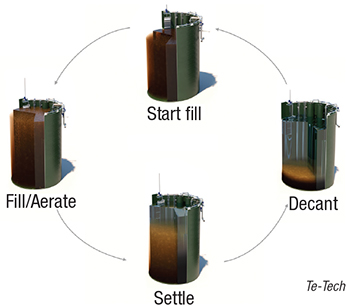A cyclic activated-sludge (AS) process, trademarked te-cycTM, combines biological treatment and solids settlement in a single treatment step, thereby significantly reducing the footprint compared to a conventional AS plant, which requires three separate processes — primary settlement tanks, aeration tanks and final settlement, says Ben Hazard, a process engineer at Te-Tech Process Solutions, Ltd. (Totton, Southampton, U.K.; www.te-tech.co.uk). “This ultimately results in a lower capital cost due to less infrastructure being required.”
The first plant of this kind was completed in 1999 at Neubrandenburg, Germany, with a nominal capacity of 140,000 PE (population equivalent). Now, Te-Tech Process Solutions has developed a modular unit that has been specifically designed for small- to medium-sized treatment works, which offers the same benefits of the larger plants, but at a smaller scale and with a design for manufacture and assembly approach in mind.

The te-cycTM process is fundamentally based on a traditional sequencing batch reactor (SBR) whereby a sequence of tank filling, wastewater aeration, solids settlement and treated effluent decanting is repeated on a continuous cycle, explains Hazard. In the te-cycTM process (diagram), there is typically 2 h of simultaneous filling and aerating, 1 h of settlement and 1 h of decanting. In the standard design, there will always be two or more tanks in parallel with their operating cycles out of phase with each other. This allows for a continuous inflow into the process as a whole, therefore eliminating the need for an upstream buffer tank, which would require energy-consuming mechanical mixing, says Hazard.
“Unique to the te-cycTM process is the inclusion and design of an anaerobic selector zone, internal return activated sludge pump and bespoke mechanically driven decanter,” Hazard continues. The combination of the anaerobic selector zone and internal recycle suppresses the growth of poorly settling filamentous bacteria and promotes the growth of floc-forming bacteria that aggregate and form a large macrofloc. These macroflocs are larger than the typical flocs formed in conventional AS or SBR processes, and as such provide two key benefits: 1) the increased size leads to a quicker and more effective settlement of solids; and 2) the macroflocs are large enough to consist of an external aerobic zone and an internal anaerobic/anoxic zone, explains Hazard. “This means that nitrification and denitrification can occur simultaneously in the aeration phase of the te-cycTM operation cycle,” he says.
Contact Us for more information or to talk about your requirements enquiries@te-tech.co.uk